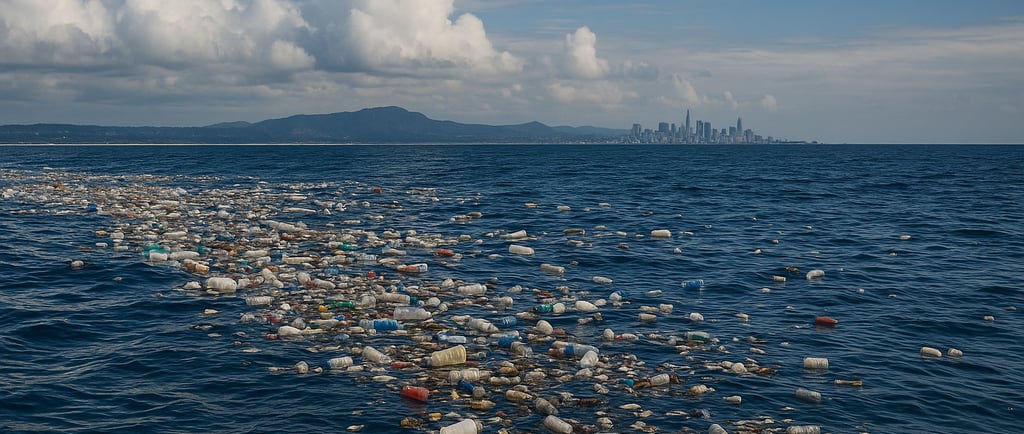The Pacific “plastic continent” : America faces up to its responsibilities
AMERICA
Thomas Dos Remedios
9/10/20257 min read


AN OCEAN TRAPPED BY GLOBALISATION
Halfway between California and Hawaii, in the heart of the North Pacific, floats one of the most striking ecological aberrations of our time: the Great Pacific Garbage Patch (GPGP), nicknamed ‘the plastic continent’. Discovered in the 1980s by American oceanographer Charles Moore, this gigantic mass of marine debris is the result of a simple yet relentless mechanism: ocean currents, organised into gyres, trap and concentrate plastic waste from both continents and ships. The North Pacific subtropical gyre, a huge marine vortex fed by the Kuroshio Current to the west, the North Pacific Current and the California Current, acts as a gigantic trap where floating debris accumulates.
Contrary to the sensationalist image of a compact island made of rubbish, the GPGP is in fact a diffuse mass, a soup of plastics of all sizes. It contains tangled fishing nets, abandoned buoys, broken containers, bottles, bags and, above all, a colossal quantity of microplastics that are invisible to the naked eye but omnipresent. These fragments, less than five millimetres in size, are the result of the degradation of the original waste under the effect of the sun and waves, and they are dispersed throughout the water column. This diffuse nature makes them extremely difficult to collect and exacerbates the scale of the problem.
Estimates by the NGO The Ocean Cleanup (2018) give an idea of the scale of the phenomenon: the GPGP covers approximately 1.6 million km², three times the size of France, and contains nearly 80,000 tonnes of plastic, representing 1.8 trillion individual pieces. Most of this waste does not even float on the surface: some of it breaks down, becomes heavier and sinks, suggesting that the total volume of plastic in the ocean is greatly underestimated. Worse still, this mass continues to grow. Every year, between 8 and 12 million tonnes of plastic are dumped into the world's oceans, and a significant proportion inevitably ends up in this Pacific gyre.
The Great Pacific Garbage Patch has therefore become much more than a scientific curiosity: it has established itself as a global symbol. It embodies the excesses of globalisation, where rampant consumption of packaged goods and industrial fishing fuel a system incapable of managing its waste. But it also reflects the particular responsibility of coastal countries, especially North America, whose plastic footprint is among the heaviest in the world.
CHAMPIONS OF PLASTIC AND INVISIBLE POLLUTION
North America plays a central role in this ecological crisis. The United States is quite simply the world's largest producer of plastic waste. A study published in Science Advances in 2020 estimates that the country generates around 42 million tonnes of plastic per year, or nearly 17% of global production, even though it accounts for only 4% of the world's population. This means that each American produces an average of 130 kg of plastic waste per year, twice the European average. Recycling, often presented as a solution, is largely insufficient: only 9% of plastic waste is actually recycled, while the rest ends up in landfills, is incinerated or escapes into the environment.
Canada, with its 4.4 million tonnes per year, has a more modest consumption in absolute terms but is just as problematic in relation to its population. Despite the gradual ban on certain single-use plastics (bags, straws, cutlery) since 2022, its recycling rate also remains low and its waste management infrastructure remains incomplete, particularly in the maritime provinces.
It should also be remembered that, for decades, the United States and Canada have been exporting huge quantities of plastic waste to Asia, particularly China. In 2016, nearly 700,000 tonnes of American plastic were sent to Chinese ports each year. However, some of this waste was poorly treated and released into the environment, ultimately ending up in the oceans. Since Beijing's ban in 2018, these exports have been redirected to Southeast Asia, where management systems are often even more fragile. This means that North America contributes to ocean pollution both directly (poorly collected waste, losses at sea) and indirectly (exports to countries unable to manage these flows properly).
The North American Pacific coastline reinforces this responsibility. The ports of Los Angeles and Long Beach together handle more than 19 million TEU containers per year, making them the largest port complex in the Americas. Seattle, Oakland and Vancouver complete this leading logistics network. Every year, thousands of containers fall into the sea due to storms and poor sailing conditions: estimates vary between 1,500 and 3,000 annual losses in the Pacific. These cargoes, often consisting of manufactured plastics, then flow directly into the subtropical gyre.
Finally, the fishing industry is a key player in this problem. Studies conducted in the GPGP show that 46% of the total mass consists of abandoned fishing gear: gillnets, trawls, lines, buoys and ropes. Most of this equipment comes from industrial fishing, which is highly developed in North America for salmon, tuna and hake. This marine debris, known as ‘ghost gear’, continues to catch fish, turtles and marine mammals long after it has been abandoned, exacerbating the ecological crisis and causing considerable economic losses for the fishermen themselves.
A LARGE-SCALE ECOLOGICAL AND ECONOMIC DISASTER
The accumulation of plastics in the North Pacific is having dramatic ecological consequences. According to the IUCN, more than 700 marine species are directly affected by plastic pollution. Sea turtles mistake plastic bags for jellyfish, their usual prey, and die of suffocation. Seabirds, such as Midway albatrosses, feed their chicks with colourful fragments that they mistake for fish: thousands of chicks die every year with their stomachs full of plastic. Marine mammals, including dolphins and whales, also ingest this waste or become entangled in abandoned nets, often with fatal consequences.
But the most insidious threat is that of microplastics. These particles, which come from the fragmentation of waste or products such as cosmetics, now contaminate the food chain at its base, being ingested by plankton. A study published in Nature in 2019 revealed that more than 90% of fish sampled in the North Pacific contained microplastics. These particles then accumulate in tissue and can end up on human plates, posing a risk to public health that has yet to be fully assessed.
The economic consequences are also considerable. The OECD estimates that plastic pollution costs the global economy between $6 billion and $19 billion a year in lost fisheries productivity, damage to tourism and clean-up costs. In the Pacific, the losses translate into a decline in catches available to fishermen, a direct cost related to lost gear, but also a damaged image of coastal areas. Hawaii and California, which are heavily dependent on coastal tourism, have to invest tens of millions of dollars each year to clean up their beaches. These rising costs clearly illustrate that plastic pollution, far from being a distant or abstract problem, poses a direct threat to local economies.
GOVERNANCE AND SOLUTIONS: BETWEEN VOLUNTARISM AND INERTIA
The management of the Great Pacific Garbage Patch reveals the inadequacy of international mechanisms. The 1973 MARPOL Convention prohibits the deliberate dumping of plastics at sea, but it does not include strict control mechanisms or truly dissuasive penalties. The United States, the world's leading maritime power, has long been reluctant to make any binding commitments. It was not until 2022 that Washington finally agreed to join the UN-led negotiations for a global plastics treaty, which is expected to be adopted by 2025. Canada, which is more favourable to multilateralism, supports this process, but its internal policies, which are still fragmented, are struggling to translate this ambition into concrete results.
In this institutional vacuum, private and associative initiatives are attempting to provide solutions. The NGO The Ocean Cleanup, founded by Boyan Slat, has been setting up floating systems capable of collecting waste in the GPGP since 2018. More than 200 tonnes have already been removed. But this amount remains tiny in relation to the scale of the problem, and researchers point out that as long as global plastic production does not decrease, these operations will be like bailing out a ship that is taking on water from all sides.
However, solutions do exist. The first is a drastic reduction in the production and consumption of single-use plastics, which has already begun in Canada but is still in its infancy in the United States. A second avenue involves making the fishing industry more accountable: traceability of gear, mandatory recovery, penalties for abandonment. The maritime sector also needs to be better regulated: increased monitoring in ports and during transport would limit container losses and improve logistics security. Finally, North America could use its diplomatic power to spearhead an ambitious global treaty.
A MIRROR OF NORTH AMERICAN CONTRADICTIONS
The management of the Great Pacific Garbage Patch reveals the inadequacy of international mechanisms. The 1973 MARPOL Convention prohibits the deliberate discharge of plastics at sea, but it does not include strict control mechanisms or truly dissuasive penalties. The United States, the world's leading maritime power, has long been reluctant to make any binding commitments. It was not until 2022 that Washington finally agreed to join the UN-led negotiations for a global plastics treaty, which is expected to be adopted by 2025. Canada, which is more favourable to multilateralism, supports this process, but its internal policies, which are still fragmented, are struggling to translate this ambition into concrete results.
In this institutional vacuum, private and community initiatives are attempting to provide solutions. Since 2018, the NGO The Ocean Cleanup, founded by Boyan Slat, has been installing floating systems capable of collecting waste in the GPGP. More than 200 tonnes have already been removed. But this amount remains tiny in relation to the scale of the problem, and researchers point out that as long as global plastic production does not decrease, these operations will be like bailing out a ship that is taking on water from all sides.
However, solutions do exist. The first is a drastic reduction in the production and consumption of single-use plastics, which has already begun in Canada but is still in its infancy in the United States. A second avenue involves making the fishing industry more accountable: traceability of gear, mandatory recovery, penalties for abandonment. The maritime sector also needs to be better regulated: increased controls in ports and during transport would limit container losses and enhance logistics security. Finally, North America could use its diplomatic power to become the driving force behind an ambitious global treaty.
Thomas Dos Remedios, for SPECTIO
The statements made are solely those of their authors and do not reflect the position of the Think Tank Spectio.
